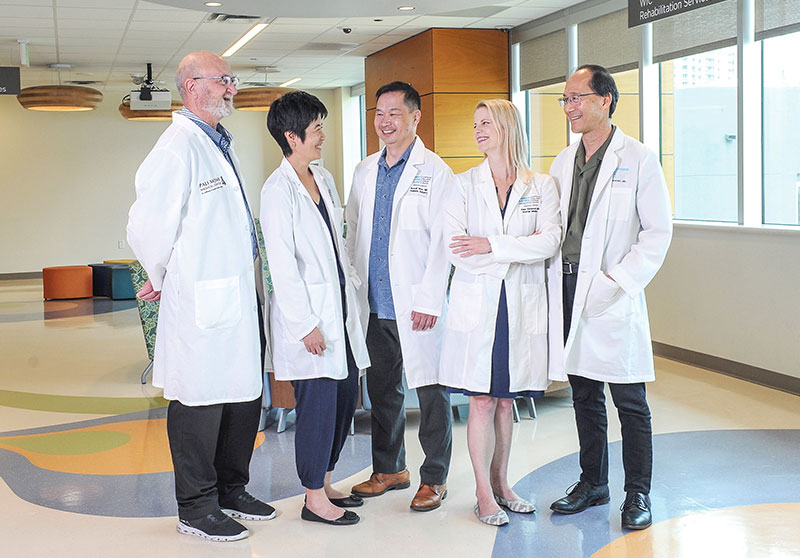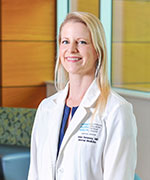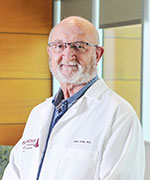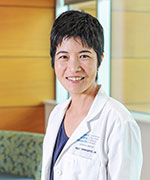The Inspiring Lives of Devoted Doctors
Reflecting back on National Doctors’ Day, five health care professionals share personal stories about their commitment to creating a healthier Hawai‘i.
National Doctors’ Day is celebrated annually on March 30 to honor the care physicians give to their patients, the work they do in their communities and their extraordinary devotion to saving lives. This day traces its roots to March 30, 1933, when Eudora Brown Almond — the wife of a physician in Georgia — began efforts to recognize doctors for their service.
Although they come from all walks of life, here in the islands, the physicians of Hawai‘i Pacific Health (HPH) share a common mission to create a healthier Hawai‘i. They stand ready for their patients and serve with dedication in the community. Hawai‘i Pacific Health Medical Group (HPHMG) was formed in 2019 to unite medical professionals across HPH’s four medical centers and multiple clinics.
HPHMG comprises more than 800 physicians, nurse practitioners, physician assistants, nurse anesthetists, optometrists, psychologists and genetic counselors. Many have been serving Hawai‘i patients for decades.
The HPHMG team works in the following clinics and medical centers across the state: Kapi‘olani Medical Center for Women & Children, Pali Momi Medical Center, Straub Medical Center and clinics, Wilcox Medical Center and Kaua‘i Medical Clinic.
HPHMG providers care for patients in their own communities. The wide network of doctors serves patients across the state — from Hawai‘i Island to Kaua‘i — for the best health outcomes possible.
The medical group collaborates closely with more than 500 physicians in Hawai‘i Health Partners — HPH’s physician-led accountable care organization.
HPHMG also works closely with the University of Hawai‘i’s John A. Burns School of Medicine to grow the next generation of doctors and health care professionals for the state.
What are a few of the personal stories of these medical providers at Hawai‘i Pacific Health? Well, take for example, five of them: Drs. Anne Dempsey, Mark Grief, Ian Okazaki, Russell Woo and Kelly Yamasato. Throughout this article, the doctors of HPH take the time to talk about their experiences and areas of expertise.
Dr. Anne Dempsey specializes in internal medicine at Wilcox Medical Center. She’s a primary care physician who survived cancer and builds strong relationships with her patients to promote preventive care.
“I stayed in Dallas to do my residency and training, and then went to Austin and was a hospitalist for nine years. I’ve been practicing for over 20 years now,” says Dempsey.
She also shares that it’s the relationships she enjoys most about her career.
“I really get to know my patients. Sometimes I even take care of their families, whether it’s their husbands or wives, their parents or adult children. It’s just been a wonderful experience. On Kaua‘i, I get to be the community doctor. I see my patients everywhere I go,” Dempsey notes.
Delving deeper into her life, Dempsey explains, “The first time I came to Kaua‘i, I said, ‘I’m going to live here someday.’ I thought it would be much later in life, but then I was diagnosed with breast cancer in September 2012. I had surgery the following month. I finished chemotherapy and radiation in the spring of 2013. After I was finished, I asked myself, ‘What kind of life do I want to be living?’ and ‘What will I regret not doing?’ The answer was to live on Kaua‘i. I joined the team at Wilcox Medical Center in 2014.”
Health management is one topic that is near and dear to Dempsey’s heart.
“We want to take care of a patient’s health before they have complications from their conditions. People can reverse their high blood pressure or improve their diabetes largely with lifestyle changes. With the Health Management Program, we work closely with patients to empower them to help themselves,” she says.
According to Dempsey, “When you get people on the right track with the right medications or the right counseling, and they’re motivated to change, it’s incredible. I have patients who say these lifestyle changes ‘saved my life.’”
She also notes that HPH has really embraced team-based care, which has been significant not only for patients, but for physicians, advanced practice providers and the nursing staff.
Dr. Ian Okazaki is a specialist in hematology and oncology at Straub Medical Center who is fascinated by the molecular aspect of cancer and finding the genes that cause cancer. The committed leader in cancer care regularly goes to Maui and to Wilcox Medical Center on Kaua‘i. HPH teams travel statewide.
Okazaki says he’s passionate about traveling to rural areas across the state to help those who need it.
“Like lots of us, my dad’s side of the family is a plantation family from the Big Island. My mom grew up in Honolulu. People need help no matter where they are,” he says. “You can’t really say that you are compassionate and committed until you make sure that the ones who have the least amount of access to health care or are among the populations that are overlooked have what they need.”
Okazaki also explains that HPH has accomplished much in cancer care that has been beneficial to the entire state of Hawai‘i.
“A big step Hawai‘i Pacific Health has taken is to integrate services as a system for cancer. Whether you live on Kaua‘i, in Central and West O‘ahu, or in town, our cancer centers are unified, and services are standardized across our system,” says Okazaki. “Our facilities and our cancer centers still have specialized care, like pediatric oncology at Kapi‘olani, but patients can expect unified services from one facility to the other from our top-notch nurses to infusion processes. Having our network of care has also allowed us to build out sites of excellence that are unique in what they offer.”
He also elaborates that HPH has complete multidisciplinary care teams.
“We’ve created specific cancer teams made up of physicians, nurses and nurse practitioners who all work together. There’s a lung cancer team, breast cancer team, skin cancer team, malignant hematology team, gastrointestinal cancer team and urologic cancer team, each focused on an individual patient’s needs. The whole intent of this system approach is to provide better expertise to all our patients. It’s better cancer care. It’s more comprehensive from screening and prevention to the entire continuum where you have palliative care and terminal care.”
Okazaki also believes that what really needs to be emphasized to everyone in Hawai‘i is that clinical research matters.
“We cannot make advances in cancer care unless we are also leading the drive to get active cancer clinical trials in Hawai‘i so that people have access to them. That’s how we make advances, that’s how cancer care improves, and that’s how survival rates improve,” Okazaki declares.
Back on O‘ahu, Dr. Mark Grief is a pioneering physician for bariatric care at Pali Momi Medical Center with nearly four decades of surgical expertise. In fact, Grief was one of the original physicians when the medical center opened in 1989.
Grief was exposed to medicine at age 16 when he worked as an operating room orderly in Kentucky. As a teen driven to be a surgeon, he also tried to become ambidextrous by trimming cabbage with his nondominant hand at a grocery store job.
Since he started his career, Grief has seen surgery dramatically evolve.
“I would say 70% of the cases I do now were not even taught when I was a surgical resident. That’s how much medicine evolves and changes. Then, operations involved a large incision so surgeons could get their hands into the body,” Grief says. “Laparoscopic surgery was new, minimally invasive and called for a small incision. I learned laparoscopic surgeries for gallbladders, hernias, colons and appendectomies after finishing training. I also developed the skills for bariatric surgery later, in 2009.”
Grief lost count of how many surgeries he’s done in his career after about 35,000 when adding up in-office procedures and major operations. For bariatric surgeries, he estimates that it’s close to a thousand.
“We’re proud that the bariatric surgery program is an accredited Center of Excellence at Pali Momi Medical Center. What we do now with bariatric surgery is the same whether you’re in California, New York or London. It’s very specific. If you are about 100 pounds overweight, your risk of dying in the next five years is drastically higher than if you undergo bariatric surgery,” Grief elaborates. “According to the American Society for Metabolic and Bariatric Surgery, with the weight-loss surgery, your diabetes goes away 92% of the time, your hypertension improves 75% of the time, and your sleep apnea goes away 96% of the time. That’s what hooked me — to know we could medically improve health with this surgery. It could reverse those complications. Those are incredible outcomes.”
Dr. Russell Woo works as an innovative pediatric surgeon at Kapi‘olani Medical Center for Women & Children.
“We treat newborns who are born with conditions that need immediate attention — they won’t survive without medical care. After their treatment, when you are able see them celebrate their 10th birthday, it’s very fulfilling. It is an honor and why I went into pediatric surgery,” he says.
Woo strongly believes in research and helped to establish surgical verification recognition at Kapi‘olani.
Recently, Kapi‘olani became the first and only medical center in Hawai‘i to be nationally recognized as a Level I Children’s Surgery Center by the American College of Surgeons.
“We’re one of about 50 hospitals across the nation with ACS’s highest distinction. It awards medical centers that have the experience, expertise and resources to provide comprehensive treatment for a wide range of complex conditions from congenital heart surgery to pediatric neurosurgery and neonatal surgery,” Woo says.
“Kapi‘olani would not have achieved this without the commitment by HPH and all its providers,” he continues. “We want to provide world-class care to Hawai‘i’s women and children.
“It wasn’t simple. Kapi‘olani had to ensure not only that it has facilities and equipment specifically designed for children; the medical team had to commit to being on-call for a range of needs 24/7 and check specialized credentialing and training for staff,” he adds. “We had to make sure that across the journey of a surgical patient — before they enter the hospital, in the hospital and back at home — that their parents had all the education, resources and collaborations to deliver the best care. One of the key aspects is detailed and consistent processes of review by a multi-disciplinary team of doctors, nurses and specialists.”
Woo is also excited about training the next generation of physicians and helping them advance the technology and treatments in the field.
For example, he helps fellow physicians further their research through HPH’s Biomedical Research and Innovation Center, which he co-chairs with Kapi‘olani pediatric cardiologist Dr. Andras Bratincsak. He also has the opportunity to work with University of Hawai‘i John A. Burns medical students to explore their own scientific studies as JABSOM’s medical student research director and as the associate chair for research in the department of surgery.
“Educating students and innovating new treatments go hand-in-hand — both are essential to the goal of providing better care for our patients now and into the future,” says Woo.
Demonstrating another of the vast array of fields that medicine covers is Dr. Kelly Yamasato of Kapi‘olani Medical Center for Women & Children. Yamasato grew up in Waimea on Hawai‘i Island and did all her medical training at JABSOM, including medical school, residency and fellowship. As a faculty member of JABSOM, a large part of her role is education and research as well.
Yamasato has a love for obstetrics-gynecology and has been instrumental in helping babies survive against all odds.
“I found myself being drawn toward trying to help those with the greatest needs during pregnancy, and therefore decided to specialize in maternal fetal medicine and take care of those with high-risk pregnancies,” Yamasato says.
“We take care of a lot of women with medical conditions such as high blood pressure and diabetes that require extra monitoring during pregnancy. Many of these conditions create pregnancy risks to both the mom and the baby,” she elaborates.
“We also care for expectant moms who do not have any medical conditions, but their baby may have a complication such as a heart defect, poor growth or other conditions that require extra prenatal monitoring and planning for neonatal care. We also take care of women with multiple gestations, such as those who carry twins and triplets. Several years ago a local mom gave birth to quintuplets — they were cared for by the Maternal Fetal Medicine team at Kapi‘olani.”
One example of an area that Yamasato has a particular interest in is periviable birth — this is when a woman is at risk for delivering her child very early, near the limits of when a baby can survive after birth.
“The counseling and decisions made by the pregnant mother in this situation are extremely complex and require a close-knit team approach. This is an example of an area of maternal fetal medicine care that we are working on at Kapi‘olani,” Yamasato adds. “To be honest, after all these years I still marvel at those first ultrasounds when a baby is a few millimeters long and you can already see that flicker of a heartbeat. To think we all started out like that. I’ve delivered some babies who’ve weighed just about a pound at birth, while the heaviest baby I’ve delivered weighed 14 pounds. On either end of the spectrum, our neonatology colleagues at Kapi‘olani provide amazing care after birth.”
Summing up their heartfelt stories, these five doctors are just a few of the hundreds of medical professionals who are part of the dedicated HPH ‘ohana of caregivers who all work in collaboration with each other. Their individual histories and specialties vary, but what ties all of their contributions together are shared values. They include close attention to team-based multidisciplinary care, forging relationships with patients and their families, an emphasis on the importance of education and research, and much more.









